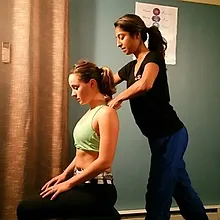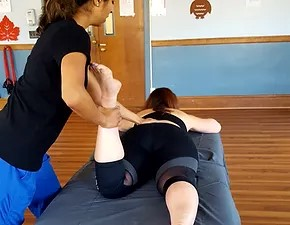Structural Bodywork
What Is Structural Integration Bodywork?
SB manages the root causes of imbalances in your body by bringing alignment to your posture, ease to your movements, and long-lasting results in your ability to adapt to the body’s responses against gravity. Imbalances in our body lead to compensations in our postural and movement patterns which may bring us chronic pain, drain us of energy, and make us prone to injury.

What does this mean for you?
- Improves posture by working on the fascia to realign your body in space, so that it works with gravity rather than against it
- Be more aware of your body from the inside and out by improving your kinesthetic intelligence.
- Decreases chronic pain, tension and stress – Addresses chronic whole-system problems rather than focusing on local acute symptoms
- Improve your Neuroplasticity is heightened so you have more room to hold experiences, thoughts, and feelings.
- Enhances physical and athletic performance
- Facilitates changes by helping your body discover new options and possibilities
- Enhance balance and flexibility – creating greater stability and base of support in the feet and looking for symmetry between left/right, front/back parts of the body
- Allow more ease, efficiency, fluidity, and graceful movement
- Facilitates more expansive breath
- Improves the relationship between anatomical structures (bones, joints, ligaments, muscles, organs, connective tissue, nerves, arteries
- Realigning the body so that it works better – Increasing the ability to complete everyday activities more easier
Contraindications:
Wait at least 6 weeks after surgery, with the permission of your doctor before undertaking structural integration. Additionally, this work may not be appropriate for those with rheumatoid arthritis or other systemic inflammatory diseases.
SB purports to be an educational process for the body’s locomotor system and is neither diagnosis nor treatment for any condition nor a substitute for competent medical attention when needed. If you have medical concerns or are under the care of a doctor, please consult your medical practitioner before undertaking structural integration. At your request, I am available to consult with any member of your treatment team.
Wait at least 6 weeks after surgery, with the permission of your doctor before undertaking structural integration. Additionally, this work may not be appropriate for those with rheumatoid arthritis or other systemic inflammatory diseases.
SB purports to be an educational process for the body’s locomotor system and is neither diagnosis nor treatment for any condition nor a substitute for competent medical attention when needed. If you have medical concerns or are under the care of a doctor, please consult your medical practitioner before undertaking structural integration. At your request, I am available to consult with any member of your treatment team.
The Structural Integration 12 Series
The series systematically unwinds restrictive patterns in the body that have developed over time so that your soft tissue system is more supportive and adaptable for your lifestyle. Each session builds on the previous one.The first four sessions address the superficial layers of the body.
The fifth to eighth sessions dive into the body’s core support systems (deeper layers of tissue and muscles).
The last four sessions integrate the work done in the previous eight sessions. In other words, we integrate the movement of the outer layer and deeper layers of tissue, the lower body and upper body, the extremities, and the connection between them (the spine, head, and neck).

What to Wear
To work effectively, I need direct access to your tissue. And because you will be asked to move around during the session, you will not be draped.
Women: underwear and a bra or shorts and a bra or a sports bra work well. If you choose to wear a sports bra, please pick one that exposes your back as much as possible.
Men: briefs or boxer briefs are best but if you prefer you can wear workout shorts.
Women: underwear and a bra or shorts and a bra or a sports bra work well. If you choose to wear a sports bra, please pick one that exposes your back as much as possible.
Men: briefs or boxer briefs are best but if you prefer you can wear workout shorts.
